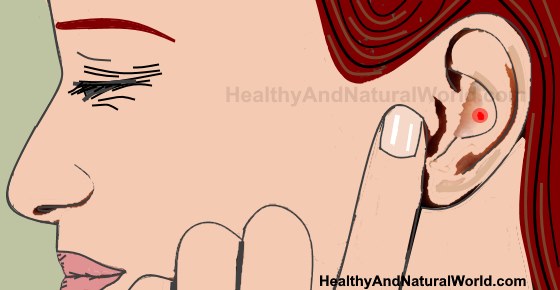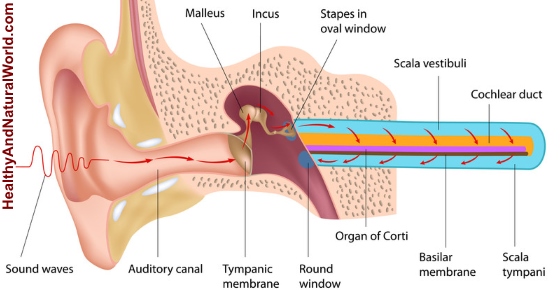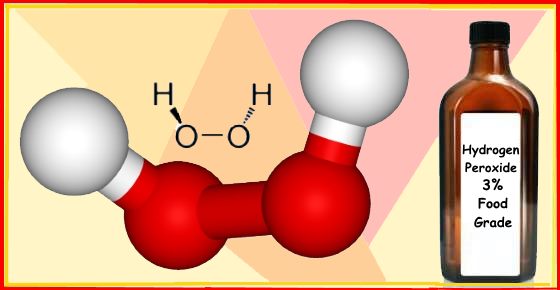Home Remedies for a Pimple in Ear That Actually Work

Pimples can develop in your ear the same way inflamed spots can affect other areas of your skin. Getting rid of painful red bumps from your ear is a challenge because the pimples can be difficult to reach. The good news is that there are many effective home remedies that can quickly deal with ear pimples and get rid of any infection.
Sometimes pimples, whiteheads, and blackheads can occur in the ear as a result of acne. However, other times blocked pores in your outer ear or inner ear can cause large bumps to form and sometimes even cysts. Some effective natural treatments for ear pimples include tea tree oil, witch hazel, and even honey to help reduce infection and inflammation.
In this article, you will find out how to treat annoying pimples that occur in and around your ear opening. You will also find out if it is safe to pop a pimple in your ear. First of all, let’s look at the reasons that pimples can affect your ear.
What Causes Pimples in Your Ear?
Acne and pimples develop when oil produced by the sebaceous glands in the skin (sebum) clog up pores. If dead skin cells accumulate in the pore, bacteria can infect the pore and an inflamed lump can appear that may or may not fill with pus.
According to the journal Clinics in Dermatology, your external ear and ear canal contain sebaceous glands and therefore inflammatory skin conditions can easily develop there. Researchers from India also found that acne can affect the area inside and around the ear.
Dr. Colin Tidy on Patient.info explains that infection in the skin can also cause a boil to occur in the ear. A common culprit for the skin infection in your ear is often damaging your ear tissue with a cotton bud or putting another object in your ear. The resulting boil can be itchy, cause irritation and even affect your hearing. In some cases, the boil bursts and drains discharge from the ear.
Types of pimples in your ear
According to the American Academy of Dermatology, blocked pores can cause a number of different kinds of pimples. All of these pimples can also occur in the inner or external part of your ear.
Blackheads and whiteheads occur in the ears when sebum, dead skin cells, and bacteria block pores. If the skin pore stays open, you will get blackheads as the oil oxidizes with the air. Small white bumps will appear in your ear if the blocked pore closes up.
Pustules in the ear are larger pimples that become infected and fill with pus. These types of pimples are harder to get rid of from the ear. However, with some patience and antibacterial home remedies, you should be able to treat them effectively.
A small boil can appear in the ear canal if the skin becomes damaged and infected.
The Best Home Remedies for Pimples in Ear
All of the following home remedies can be used to treat all kinds of pimples in your ear. They will help to kill off any infection in your skin’s pores and help drain any pus and discharge that can be causing ear pain.
Tea tree oil
Tea tree oil is usually the number one choice when it comes to treating skin infections. The antibacterial properties of tea tree oil make it a great remedy to help quickly get rid of ear pimples. What’s more, tea tree oil is also a natural anti-inflammatory agent that will reduce the inflammation in skin bumps.
The Medical Journal of Australia reported that tea tree oil is just as effective as some pharmaceutical acne medications in helping to get rid of pimples. Other studies have confirmed that tea tree oil can help reduce symptoms of acne vulgaris and prevent outbreaks of acne.6
How to use tea tree oil for a pimple in the ear:
You can effectively use tea tree oil to get rid of an irritating pimple in your outer ear. Unlike other essential oils, tea tree oil can be used directly on the skin as a spot treatment. This is what you should do to promote quick healing of a pimple in your ear:
- Put 1-2 drops of tea tree oil on a cotton bud.
- Carefully apply the tea tree oil to the pimple in your outer ear. (Be very careful never to put the cotton swab too far into your ear).
- Repeat 2-3 times a day to help reduce the inflammation and get rid of the ear pimple.
To help boost the healing power of all the following natural recipes mentioned in this article, you can add a drop or 2 of tea tree oil to help treat acne.
Tea tree oil and coconut oil
A combination of tea tree oil and virgin coconut oil makes an effective acne treatmentfor pimples in your ear. One of the reasons that coconut oil works effectively against pimples is that it contains lauric acid which is antimicrobial.
A study published in the Journal of Investigative Dermatology found that lauric acid kills off the Propionibacterium acnes strain of bacteria. Lauric acid helped to reduce inflammation in acne flare-ups and it was suggested that it can be used as an effective alternative treatment for acne vulgaris.7
How to use:
To help soothe an inflamed pimple in your ear and get rid of the annoying spot for good, use a combination of tea tree oil and virgin coconut oil. This is what you should to treat your ear pimple:
- Mix 2-3 drops of tea tree oil with one tablespoon virgin coconut oil.
- Apply some coconut oil mixture to the zit in your ear with a cotton swab.
- Gently massage the oil into the pimple and the skin around it so the antibacterial properties of the remedy can go to work (remember to wash your hands first).
- Apply 2-3 times a day until the red bump in your ear has gone completely.
Witch hazel
Witch hazel can help to drain pus from an infected bump in your ear and help get rid of the pimple quickly. The benefit of witch hazel for acne pimples is that it is a natural astringent with antiseptic properties.
There have been various studies into the skin-healing properties of witch hazel. For example, the book Herbal Treatment for Dermatologic Disorders reported on a study showing that the astringent properties of witch hazel are useful for treating acne.
How to use:
It is very easy to use witch hazel to get rid of whiteheads, blackheads, and pimples in your ear. Here is how to make witch hazel toner for pimples in your ear.
- In 1 oz. witch hazel add 3 drops tea tree oil and 3 drops lavender oil.
- Apply the natural remedy to the pimple in your ear with a cotton ball.
- Allow to dry.
- Repeat 2-3 times a day to help get rid of pimples and prevent pores in your ear getting blocked up again.
Baking soda
There are a number of reasons that baking soda is good for treating acne and can help remove a pimple from your ear. Baking soda is a natural anti-inflammatory agent that can reduce the size of red bumps that acne cause. Baking soda also helps to dry up excess oil that causes clogged pores.
Another benefit of baking soda is that it also helps to kill off bacteria that can infect blocked pores. A study from 1997 reported that baking soda can destroy various strains of bacteria.
How to use:
Make a simple paste with baking soda and water to dry out the pimple in your ear and reduce irritation. To boost the antibacterial properties of this baking soda remedy, you can add a few drops of tea tree oil.
- Mix some water in baking soda to make a smooth paste.
- Add 2-3 drops of tea tree oil.
- Apply the paste to the pimple on your outer ear. (You shouldn’t put the paste in your ear canal or inner ear).
- Leave for 10-15 minutes before rinsing off with warm water.
For more ideas on how to get rid of acne quickly with baking soda, please read my complete guide on baking soda for acne and pimples.
Essential oils for ear pimples
Apart from tea tree oil, there are many great essential oils you can use to get rid of an inflamed bump in your ear. You can read more about the best 17 essential oils for acne, but here are 3 of the best for treating that annoying pimple in your ear.
To use these essential oils in treating a pimple in your ear, you should use the recipe of 1 tablespoon carrier oil with 2-3 drops of essential oil.
Lavender. A study published in the journal Molecules found that lavender essential oil has antibacterial activity against Propionibacterium acnes strain of bacteria. Lavender is also gentle enough to use directly on the ear pimple as a spot treatment.
Chamomile. Known for its soothing properties, chamomile essential oil can reduce inflammation in skin infections as well as helping to calm your nerves. A review on the medicinal properties of chamomile found that it has an antibacterial effect that also helps to soothe skin irritation, rashes, and sores.
Sandalwood. Research on the effectiveness of using sandalwood essential oil in acne remedies found that its anti-inflammatory activity helps to relieve acne. Sandalwood helped to lessen the severity of acne and reduce the number of pimples on the skin.
Apple cider vinegar (ACV)
You can use diluted raw unprocessed apple cider vinegar to get rid of a painful bumpin your ear. The acetic acid in apple cider vinegar acts as a chemical peel to dissolve layers of dead skin cells that can block pores to prevent whiteheads, blackheads, and zits. Also, the antiseptic nature of apple cider vinegar helps to remove bacteria and prevent more infections that cause pimples.
The journal Annals of Dermatology reported that excess sebum and P. acnes bacterial strain elevate the skin’s pH levels which can contribute to acne. The acidic properties of apple cider vinegar can help to lower the skin’s alkalinity and help treat acne pimples.
How to use:
A natural raw apple cider vinegar toner can help to get rid of an itchy, inflamed pimple in your ear. This is what you should do to use apple cider vinegar to help an ear pimple heal faster:
- Dilute apple cider vinegar with water in equal quantities.
- Using a cotton ball dipped in the apple cider vinegar remedy, place the ball on the pimple in your ear for a few minutes.
- It may sting a little. However, if it stings too much, rinse your ear with warm water. After a few applications, the stinging sensation should get better.
- Repeat 2-3 times a day until you no longer have whiteheads, blackheads or any other zit in your ear.
Aloe vera
You can help soothe a large boil in your ear by applying some healing aloe vera gel. It’s well known that aloe vera has the power to ease skin inflammation and speed up the healing time of wounds. Aloe vera is also well tolerated on sensitive skin and can help to quickly get rid of an ear pimple.
The Indian Journal of Dermatology reported that aloe vera has an anti-acne effect on the skin and can help to increase the production of collagen. Applying aloe vera to inflamed skin can also help to reduce bacterial infections and soothe itchiness.
Aloe vera is also effective at treating larger outbreaks of acne, for example, acne that covers your back.
All you have to do to use aloe vera to get rid of a large boil or a pimple from your ear is to regularly apply aloe vera gel several times a day. Continue doing this until the pimple is no longer red, itchy, and causing you discomfort.
Honey
Honey is a surprising natural acne treatment that can safely be used in your ear to get rid of a pimple. Apart from being a delicious food, honey also possesses medicinal properties and can be as effective as antibiotic treatments when treating acne outbreaks.
The journal BioMed Research International looked at the effect of honey on curing acne. It was found that honey had a positive effect in reducing sebum and P. acnes bacterial strains. This effect helps to limit bacterial growth in infected follicles.
How to use:
This is what you should do to make a pimple treatment to get rid of a bump or boil in your ear:
- Mix 1 teaspoon honey with one drop tea tree oil and one drop lavender oil.
- Apply the natural remedy to the pimple in your ear and leave for 10-20 minutes.
- Rinse with warm water.
- Use the home remedy several times a week on your ear pimple to help speed up the healing time.
How to get rid of blackheads from your ear
Most people who have pimples in their ears suffer from blackheads. Most of the natural treatments in this article, especially witch hazel and baking soda treatments, work well to lessen the number of blackheads in your ear.
There are a few other ways to get rid of blackheads that occur in your ear. One way to remove blackhead pimples from your ear is by steaming. This is what you should do:
- Pour some boiling water into a bowl and put in a few drops of lavender oil.
- Tilt you head to the side so that your ear is over the steam and cover your head with a towel.
- Keep your head in place for 5-10 minutes to allow the antibacterial effect of the lavender oil kill off bacteria and let the steam open your pores.
- Gently ease out the blackhead with clean fingers.
Should you pop a pimple in your ear?
It can be tempting to try and pop a large pus filled pimple in your ear. However, it is a bad idea to pop any kind of pimple, especially one in your ear.
Dr. Zakiya Rice on WebMD says that the pus inside a large pimple is full of grime, oil, and acne bacteria.15 If the bacteria ooze out into your inner ear, it could cause an ear infection which can be difficult to treat.
Dr. Rice also warns that squeezing and picking at a pimple could just push the infection further into your skin causing, even more inflammation, infection, and swelling.
The advice when tempted to pop a pimple in your ear is simple: don’t do it, but be patient and use the natural remedies for getting rid of pimples that are mentioned on this page.
How to prevent pimples in your ear
Of course, it is always easier to prevent pores in your ears clogging up and becoming infected pimples. Here are some great ways to avoid the irritation of a red, itchy bump causing discomfort in your inner or outer ear:
- Always wash your hand before touching your ears.
- Don’t use cotton buds or any other object to clean your ear canal. This can force germs in your ear and cause a boil or pimple to develop.
- Clean any ear buds, ear plugs or headphones that you use weekly with tea tree oil to remove any bacteria from them.
- Dry your ears after every shower to remove excess oil and prevent sebum clogging up the open pores.


